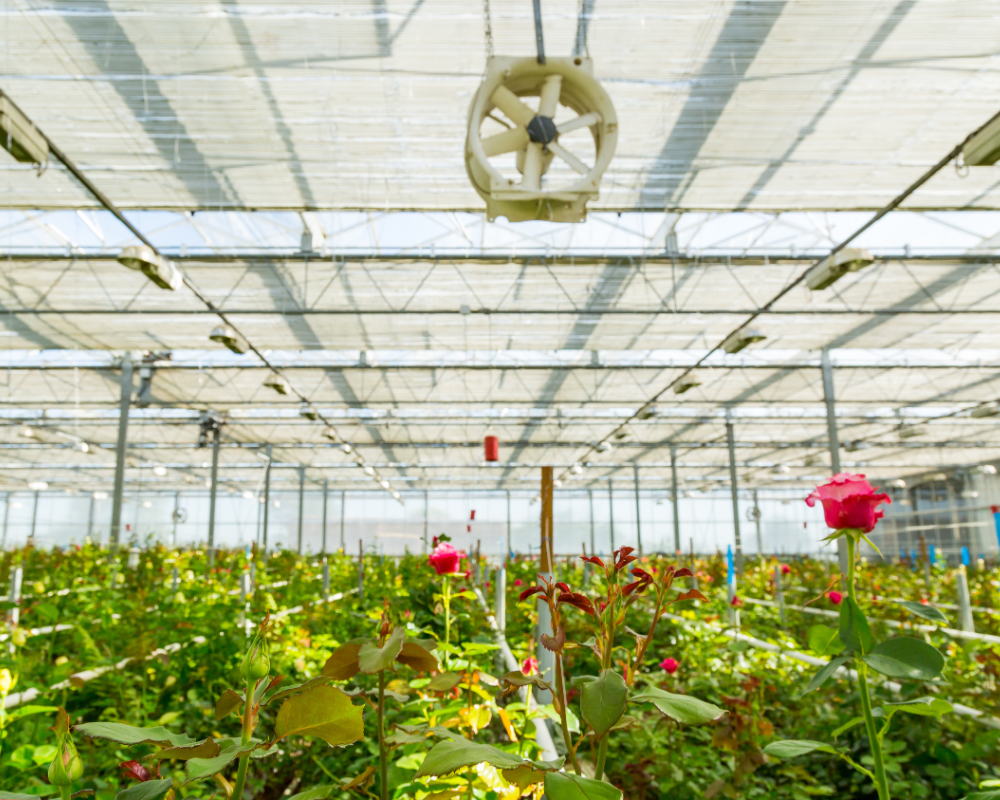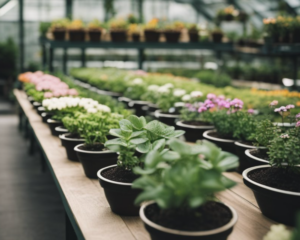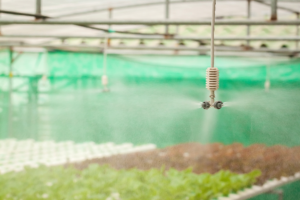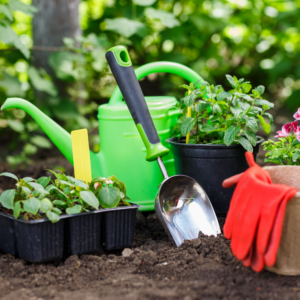Today we’re diving into the world of greenhouse ventilation! In this guide, we’ll cover everything you need to know about the importance of proper ventilation, the different types of ventilation systems, and how to maintain them for optimal performance. So, whether you’re a seasoned pro or just starting out, buckle up and get ready to learn how to keep your greenhouse fresh and breezy!
Understanding Greenhouse Ventilation
Importance of Proper Ventilation
Alright, let’s talk about why proper ventilation is so crucial for your greenhouse. It’s like giving your plants a breath of fresh air – literally!
Temperature Regulation
First off, ventilation helps regulate temperature, humidity, and CO2 levels. It’s like creating the perfect climate for your plants to thrive in. Without proper ventilation, your greenhouse can turn into a stuffy, stagnant environment that’s a breeding ground for all sorts of nasty pathogens and diseases. Trust me, you don’t want your precious plants falling victim to that!
But ventilation isn’t just about preventing the bad stuff. It also promotes the good stuff, like pollination and fruit yield. By circulating air and moving pollen around, you’re basically playing matchmaker for your plants, helping them create beautiful, bountiful harvests.
Moisture Control
And let’s not forget about moisture control. Too much moisture can lead to mold and mildew, which is like the equivalent of a bad hair day for your plants. Good ventilation helps keep that excess moisture in check, so your plants can stay fresh and fabulous.
But wait, there’s more! Proper ventilation can also prevent heat stress during those scorching summer days. It’s like giving your plants a refreshing blast of AC when they need it most.
So, investing in a quality ventilation system isn’t just a luxury – it’s a necessity for any serious greenhouse grower. Not only will it lead to healthier, happier plants, but it can also save you money on maintenance costs in the long run. It’s a win-win situation!
Types of Greenhouse Ventilation Systems
Now that we know why ventilation is so important, let’s dive into the different types of systems you can choose from.
1. Natural Ventilation
First up, we have natural ventilation. This is like the au naturale approach to greenhouse climate control. It uses vents, louvers, and roof openings to let fresh air in and hot air out, creating a natural flow of air. It’s cost-effective, energy-efficient, and perfect for those who like to keep things simple.
2. Mechanical Ventilation
On the other hand, if you want more control over your greenhouse environment, mechanical ventilation might be the way to go. This involves using fans, shutters, and automated controls to regulate air circulation and temperature. It’s like having a high-tech climate control system for your plants. If you’re running a large-scale operation or want to get really precise with your growing conditions, mechanical ventilation is the way to go.
3. Combination Ventilation
But wait, who says you have to choose just one? Combination ventilation systems give you the best of both worlds by integrating natural and mechanical ventilation. It’s like having your cake and eating it too! With a combination system, you can take advantage of the benefits of both methods and create the ultimate growing environment for your plants.
No matter which type of ventilation system you choose, understanding how they work is key to effectively managing your greenhouse climate. So, take some time to research and explore your options – your plants will thank you for it!
Key Components of Greenhouse Ventilation Systems
Ventilation Fans
First off, let’s talk about what ventilation fans actually do. Their main job is to keep the air moving, which helps regulate temperature and humidity levels. They’re like the personal air conditioners for your plants, making sure they’re always comfortable and happy.
Now, there are a few different types of ventilation fans you might come across in a greenhouse setting:
1) Ceiling Fans
These are the big kahunas, installed right up top on the greenhouse ceiling. They’re great for promoting air circulation from above, which helps keep the temperature and humidity levels in check.
2) Wall-Mounted Fans
As the name suggests, these fans are mounted on the walls of your greenhouse. They’re the sidekicks to the ceiling fans, helping to push the air around and make sure every nook and cranny gets its fair share of fresh air. No plant left behind, am I right?
3) Exhaust Fans
Their job is to get rid of all the stale air and excess moisture that can build up in your greenhouse.
But why are ventilation fans so important? Well, let me tell you, they offer a whole host of benefits for your greenhouse and your plants:
- Improved Air Circulation: By keeping the air moving, ventilation fans help prevent stagnant, stuffy air from building up. This means your plants are always getting a nice, fresh breeze, which they absolutely love. Happy plants, happy life!
- Temperature Regulation: Ventilation fans are crucial for managing the temperature inside your greenhouse. They help prevent those dreaded hot spots and cold zones, keeping the temperature just right for your plants to flourish. No more wilted, heat-stressed plants on your watch!
- Humidity Control: Too much moisture in the air can lead to all sorts of nasty problems, like mold and mildew. Ventilation fans help keep the humidity levels in check, so your plants can breathe easy and stay healthy. It’s like a spa day for your plants, minus the cucumbers on the eyes.
Louvers and Shutters
Now, let’s talk about the dynamic duo of greenhouse ventilation: louvers and shutters. These clever little devices work hand-in-hand with your ventilation fans to create the perfect environment for your plants to grow and thrive.
First, let’s talk about what louvers and shutters actually do. They’re like the adjustable windows of your greenhouse, allowing you to control the amount of air and light that comes in. And with that comes a few awesome benefits:
- Ventilation Control: Louvers and shutters are your go-to tools for fine-tuning the ventilation in your greenhouse. By adjusting them, you can let in just the right amount of fresh air to keep your plants happy and healthy.
- Light Management: Too much direct sunlight can be a real problem for some plants, causing them stress and even damage. Louvers and shutters allow you to regulate the amount of sunlight that comes in, creating the perfect light conditions for your plants to thrive.
- Temperature Regulation: By controlling the amount of air that comes in and out, louvers and shutters also play a key role in regulating the temperature inside your greenhouse. So that means no overheating, even on the hottest days. It’s sort of like having a personal thermostat for your plants!
Types of Louvers and Shutters
- Horizontal Louvers: These are the classic option, with adjustable slats that let you control the airflow and light levels with precision. It’s like having a personal set of Venetian blinds for your greenhouse!
- Roll-up Shutters: These are the heavy-duty option, perfect for when you need complete control over the environment inside your greenhouse. You can roll them up or down as needed, providing total protection from the elements. It’s like having a personal security system for your plants!
- Motorized Louver Systems: These are the high-tech option, with automated controls that let you adjust the louvers and shutters with the touch of a button. It’s like having a personal robot assistant for your greenhouse ventilation needs!
So, there you have it – your rundown on louvers and shutters. Moving right along, let’s transition to sensors and controls.
Sensors and Controls
First off, sensors are like the eyes and ears of your greenhouse. They’re constantly monitoring important environmental factors like temperature and humidity, gathering data in real-time. It’s like having a highly attentive assistant that never takes a break!
Automated Controls
But what good is all that data if you can’t put it to use, right? That’s where automated controls come in. They’re like the brain of the operation, taking all the information from the sensors and using it to make smart decisions about ventilation settings.
That’s the beauty of this precision control. It ensures that your greenhouse environment stays optimized for plant health and productivity, no matter what’s going on outside. No more guesswork, no more manual adjustments – just a perfectly balanced growing space, 24/7.
In conclusion, sensors and automated controls are the dynamic duo that every modern greenhouse needs. They work together seamlessly to monitor, adjust, and optimize your greenhouse environment, ensuring that your plants have everything they need to thrive. It’s the ultimate way to take your greenhouse game to the next level!
Greenhouse Ventilation: Maintenance and Troubleshooting
Regular Maintenance
Just like any other system, your ventilation setup needs a little TLC from time to time. Regular maintenance is key to keeping things running smoothly. This means cleaning fans, vents, and louvers to get rid of any dirt or debris, lubricating moving parts to keep them from wearing out, and inspecting and replacing any worn or damaged components.
Several components within a ventilation system may experience defects or malfunction over time. It’s important to be aware of common issues that may warrant repair or replacement:
- Deteriorated fan blades or motor
- Corroded or damaged ductwork
- Failed sensors or control mechanisms
- Worn-out belts and pulleys
Think of it like giving your ventilation system a spa day – a little pampering goes a long way!
Troubleshooting Common Issues
Even with regular maintenance, issues can still pop up from time to time. Here are a few common problems to watch out for:
- Poor airflow: If the air in your greenhouse feels stale and stagnant, it could be a sign that your ventilation system isn’t working as it should.
- Uneven temperature distribution: Are some parts of your greenhouse too hot while others are too cold? That could mean your ventilation system isn’t distributing air evenly.
- Excessive humidity: If the air feels too muggy and damp, your ventilation system might not be removing enough moisture.
Don’t worry though – with a little troubleshooting, you can get things back on track in no time!
Ventilation System Optimization
Maximizing Efficiency
Want to get the most bang for your buck when it comes to ventilation? Here are a few tips to maximize efficiency:
1. Be strategic about where you place your fans and vents. By putting them in the right spots, you can create a natural flow of air that maximizes efficiency and minimizes energy waste.
2. Combine natural and mechanical ventilation for the ultimate growing environment tailored to your plants’ needs.
3. Adjust your ventilation settings based on seasonal changes to keep your plants comfortable all year round.
Energy Efficiency Considerations
Let’s not forget about energy efficiency! Here are some ways to save energy and reduce your carbon footprint:
1. Choose fans and motors that are designed to use less energy without sacrificing performance.
2. Use a variable speed drive (VSD) to adjust fan speed based on current conditions, so you’re not wasting energy running them at full blast all the time.
3. Consider powering your ventilation system with renewable energy sources like solar panels or wind turbines.
The Future of Greenhouse Ventilation
Emerging Technologies
As technology evolves, so does the world of greenhouse ventilation. Here are a few emerging technologies to keep an eye on:
- Smart sensors and IoT devices that let you monitor and control your ventilation system from anywhere, anytime.
- Predictive maintenance systems that use advanced algorithms and machine learning to predict when components might fail, so you can replace them before they cause problems.
- Advanced automation and AI that can create a smarter, more efficient, and more effective ventilation system than ever before.
Exciting stuff, right?
Conclusion
Phew, that was a lot of info to take in! But don’t worry – with this guide in your back pocket, you’re well on your way to becoming a greenhouse ventilation pro.
Just remember, proper ventilation is key to keeping your plants healthy and happy. By understanding the different types of systems available, how they work, and how to maintain and optimize them, you’ll be able to create the perfect growing environment for your leafy friends.
So go forth and ventilate! Your plants will thank you for it.
Master the Art of Greenhouse Maintenance: 7 Proven Tips for Healthy Plant Growth!
Greenhouse Ventilation
Greenhouse Ventilation
Greenhouse Ventilation
Greenhouse Ventilation
Greenhouse Ventilation
Greenhouse Ventilation
Greenhouse Ventilation
Greenhouse Ventilation
Greenhouse Ventilation
Greenhouse Ventilation
Greenhouse Ventilation
Greenhouse Ventilation
Greenhouse Ventilation
Greenhouse Ventilation









